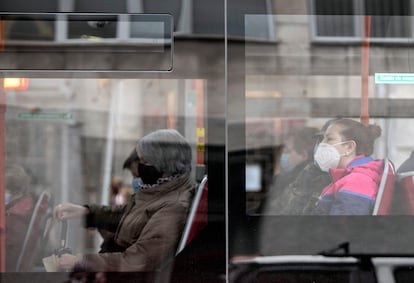Coronavirus incidence rate falls in most Spanish regions
The 14-day cumulative number of cases per 100,000 inhabitants now stands at 436, which is still far above the 250 considered to indicate a situation of “extreme risk”

The incidence rate of the coronavirus in Spain is falling day by day. “It is dropping, but these are still very high figures,” said on Thursday Fernando Simón, the director of the Health Ministry’s Coordination Center for Health Alerts (CCAES). The 14-day cumulative number of coronavirus cases per 100,000 inhabitants has fallen to 436, according to the ministry’s latest report, which was released last night. Ten days ago, this key indicator reached a new record for the pandemic, at 529. At this rate, however, it will be difficult for Spain to stop transmission in the short term, given that a cumulative number of 250 is considered “extreme risk,” according to the Health Ministry itself.
The latest report adds 252 Covid-related fatalities to the overall death toll, well below the 435 reported on Tuesday, which marked a record high for this second wave. Thursday’s figure is the smallest rise in victims in 24 hours since November 3. The peaks of new infections seen two or three weeks ago led to the high number of deaths seen in the most recent ministry reports. Now it would seem that the falling number of new cases is being reflected in the numbers of fatalities, with the former starting to go down on November 9. In total, 42,291 official coronavirus deaths have been recorded by the Health Ministry, although the real number of victims is likely to be much higher.
The latest report adds 252 Covid-related fatalities to the overall death toll, well below the 435 reported on Tuesday
The cumulative death toll over the last seven days was 1,830 in Thursday’s report, compared to 1,975 a week ago. This indicates that there will also be a fall in this parameter over the coming days, given that just over 15 days have passed since the rise in cases stabilized.
The presence of the virus has fallen in the majority of Spain’s regions. But it has grown in Cantabria, where the incidence rose from 533.49 to 547.26 in the last 24 hours, and in Asturias, where it went up 0.24% to 649.59. In Valencia, there was also a slight rise, of 0.11% to 299.53. The region where the incidence is highest is Castilla y León, with 794.19, followed by the Basque Country (718.64) and the North African exclave city of Ceuta (746.66). The Canary Islands continues to be the Spanish territory that has the virus best under control, with a 14-day cumulative number of coronavirus cases per 100,000 inhabitants of 82.66.
Thursday’s report registered 16,233 new cases, nearly 1,000 more than the previous day. The figure is still very high, but far from the 20,000 daily diagnoses that were regularly being seen during the previous three weeks.
Fernando Simón also warned on Thursday of “considerable pressure on the healthcare system,” both in the primary system and the country’s hospitals. The occupation of hospitals is falling “very slowly,” according to Simón, from 16.47% of beds occupied by Covid patients to 15.18% in the last seven days. For the same period, the occupation of intensive care unit (ICU) beds fell from 31.96% to 31.66%. For the risk to be considered low, this last rate should be between 5 and 10%. “We are expecting a slight fall in the coming days,” added Simón on Thursday night, also pointing to the fall in positivity rates. This means that cases are being detected more effectively, with the percentage falling from 12.57% last week to 10.5% yesterday.
English version by Simon Hunter.
Tu suscripción se está usando en otro dispositivo
¿Quieres añadir otro usuario a tu suscripción?
Si continúas leyendo en este dispositivo, no se podrá leer en el otro.
FlechaTu suscripción se está usando en otro dispositivo y solo puedes acceder a EL PAÍS desde un dispositivo a la vez.
Si quieres compartir tu cuenta, cambia tu suscripción a la modalidad Premium, así podrás añadir otro usuario. Cada uno accederá con su propia cuenta de email, lo que os permitirá personalizar vuestra experiencia en EL PAÍS.
¿Tienes una suscripción de empresa? Accede aquí para contratar más cuentas.
En el caso de no saber quién está usando tu cuenta, te recomendamos cambiar tu contraseña aquí.
Si decides continuar compartiendo tu cuenta, este mensaje se mostrará en tu dispositivo y en el de la otra persona que está usando tu cuenta de forma indefinida, afectando a tu experiencia de lectura. Puedes consultar aquí los términos y condiciones de la suscripción digital.
More information
Últimas noticias
Most viewed
- Sinaloa Cartel war is taking its toll on Los Chapitos
- Oona Chaplin: ‘I told James Cameron that I was living in a treehouse and starting a permaculture project with a friend’
- Reinhard Genzel, Nobel laureate in physics: ‘One-minute videos will never give you the truth’
- Why the price of coffee has skyrocketed: from Brazilian plantations to specialty coffee houses
- Silver prices are going crazy: This is what’s fueling the rally










































